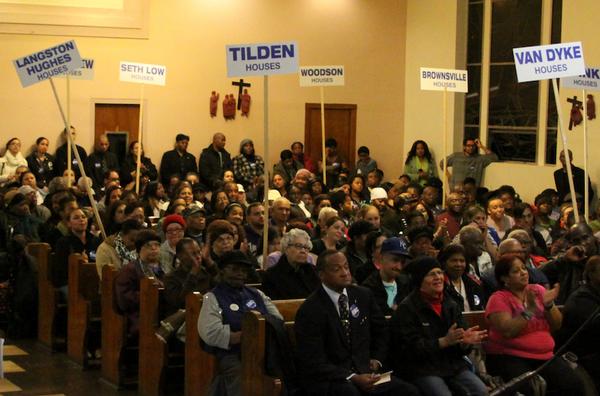
Photo by: Adam Bell
Attendees presented a lengthy list of repair problems generated by a survey of local NYCHA developments.
NYCHA officials this week promised a roomful of irate residents of Brooklyn housing developments that a long list of repair and maintenance issues would be resolved by the holidays.
Now, says one organizer of the event, “it’s accountability time.”
Ahead of the meeting on Monday night at Our Lady of Mercy Church on Mother Gaston Boulevard, local pastors working with the community group East Brooklyn Congregations had spent months collecting detailed descriptions of problems with apartments at the Bay View, Breukelen, Borinquen Plaza, Boulevard, Brownsville, Bushwick, Cypress Hills Glenmore, Howard, Kingsborough, Langston Hughes, Linden, Long Island Baptist, Nostrand, Pennsylvania-Wortman, Pink, Red Hook, Rutland, Tilden, Seth Low, Unity, Van Dyke, Weeksville Gardens and Woodson developments.
According to some of the approximately 450 people who attended, NYCHA’s vice president for operations, Carlos Laboy-Diaz, promised to fix the problems by Christmas.
“If repair requests are part of our backlog, they will be eliminated by the end of the year,” NYCHA spokesperson Sheila Stainback tells the Brooklyn Bureau. She says the vow made at the meeting was part of NYCHA’s larger effort to whittle down the repair backlog which, according to the authority, has already been reduced by 80 percent.
A range of complaints
The problems ranged from broken kitchen cabinets and walls in need of paint to gas outages, dead electrical outlets, mice, roaches, falling plaster and persistent mold.
In one apartment at the Linden Houses, tenants complained, “for the past two years my apartment has been cold all the time. I have been using heaters to keep my apartment warm.” A resident at the Langston Hughes Houses told the survey: “I need and exterminator my apartment is infested with bedbugs.”
“There are a lot of people living in conditions they shouldn’t be living in,” says Nyginer Brewer, a Langston Hughes resident who attended the meeting. “Too many stories. Stories after stories.”
While NYCHA has often struggled with maintenance, Brewer says conditions have worsened recently. “They have deteriorated over the years,” she says, recalling that when she moved in 16 years ago, “There wasn’t garbage in the always. There wasn’t urine in the elevators.” Tenants are accountable for some of that, Brewer acknowledges, but adds: “There are just some things they can’t point at the tenants for,” like mold or collapsing ceilings.
For 16 years, Brewer has had no vent in her bathroom, which has fed a mold problem that exacerbates her six-year-old daughter’s asthma. “She loves to dance, so I don’t need anything that’s going to impede her,” she adds. “You need to breathe to dance.”
Fiscal pressures play a role
NYCHA, the nation’s oldest and largest public housing authority, has been struggling for several years with a two-pronged fiscal crisis.
On one hand, federal support for daily operating expenses has lagged the cost of those services. On the other, federal capital funding has fallen steeply short at a time when many of the NYCHA buildings are reaching the point in their life-cycle of needing major repairs.
Father Ed Mason, the pastor of Our Lady of Mercy and Our Lady of the Presentation churches, says the current rash of problems at the 23 NYCHA developments in his parish is just the compounding of neglected issues from years gone by. “When you don’t fix one person’s leak, it becomes not one person’s leak but two people’s leak,” he says.
The housing authority, which operates 334 developments that house 400,000 people (and also operates a Section 8 program that funds housing for another 230,000 New Yorkers), was on track to run a $13 million operating deficit this year, and faced a $78 million gap next year, according to the agency’s current financial plan. Federal budget sequestration has not only deepened this year’s hole, but also clouded next year’s budget picture with uncertainty.
NYCHA’s budget balance is not helped by the city charging it roughly $100 million a year to cover police and sanitation services and payments in lieu of taxes.
A substantial part of NYCHA’s portfolio consists of developments built by the city and state, but both Albany and City Hall stopped annual financial support years ago.
More than money
Brewer says resource shortages aren’t the only thing she blames for the maintenance problems. There’s also a tendency to do quick fixes rather than real solutions—like painting over mold—and a staffing structure that leads to a lot of “that’s not my department” answers.
“You never get to the right person,” she says.
Part of the problem, Mason says, is NYCHA’s system for tracking complaints by issuing repair tickets. Sometimes a single issue generates multiple ticket numbers, making it hard to tell what’s been resolved or how long a problem has been present.
Mason says that at Monday’s meeting, NYCHA officials blamed some of the delays on difficulty gaining access to apartments—something Mason says community organizers could help them overcome.
The original version of this article did not mention the impact of federal sequestration.








